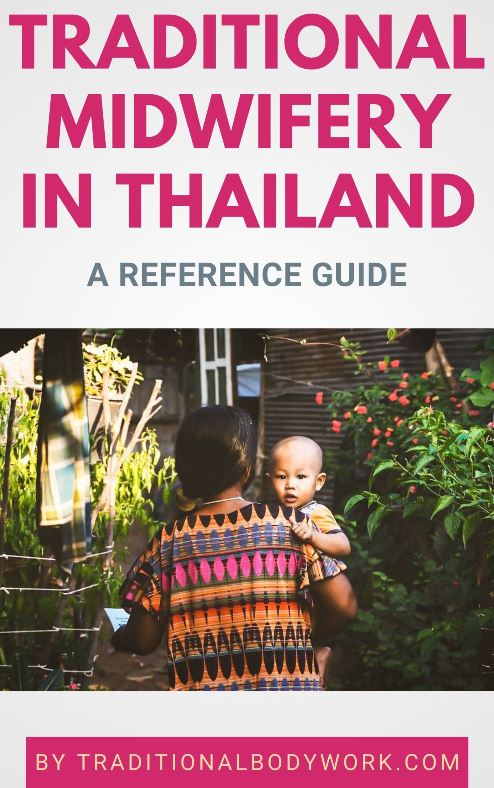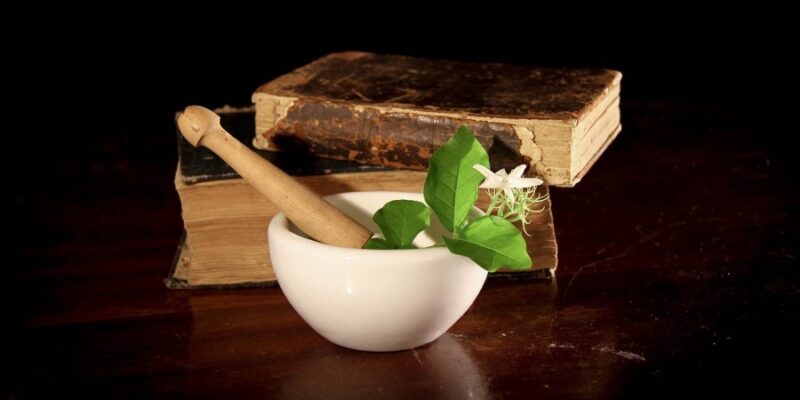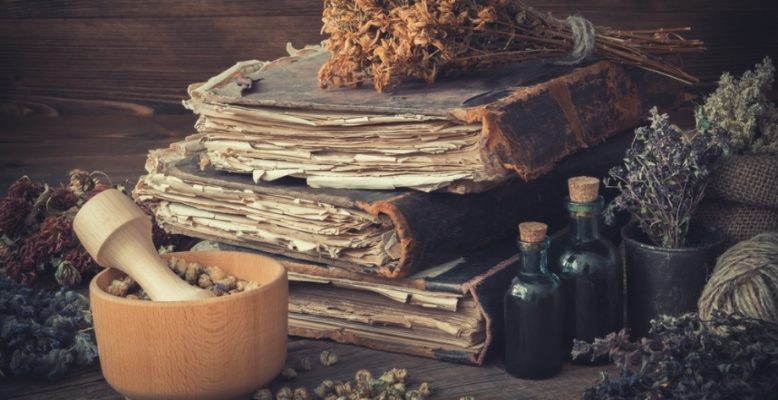
Thai Traditional Medicine has a variety of treatments to promote recovery and healing of the mother after childbirth.

The time after giving birth in Thailand is traditionally called the Yu Duan postnatal confinement period. It’s a so-called “rite of passage” and takes about thirty days in which the new mother goes into a kind of seclusion, a time that includes a range of activities and restrictions, and various specific treatments.
A popular and much used treatment modality is the use of certain medicinal herbs which can be used orally by eating and drinking, through the skin by bathing, soaking, steaming, vaporization, massage with herbal compresses or herbal packs, or through the lungs by inhaling and breathing.
The actual types of applications may vary considerably depending on the region in Thailand and moreover — on the purpose of the treatment. The expected health benefits of herbal applications after childbirth are as follows:
- Stimulates blood circulation to heal or prevent infections and inflammations;
- Increases blood cells production to replace lost blood during delivery and to prevent anaemia;
- Stimulates breast milk production;
- Supports uterine contraction and abdominal normalization;
- Stimulates the secretion of lochia (vaginal discharge);
- Reduces muscle and joint pains;
- Promotes a healthy skin;
- Reduces bad smells;
- Revitalizes the vagina;
- Keeps away “bad spirits”;
- Gives general well-being;
- Revitalizes the mother;
- Prevents illnesses later in life such as blurred vision, headaches, and general fatigue.
In any case, Thai herbal baths, steaming, soaks, inhalations, and herbal compress massages are the treatments most used during the postpartum period.
Below we take a look at some of the herbs that are most frequently applied. Note that — in most cases — a combination i.e. concoction of fresh or dry herbs and/or aromatic oils is used instead of just one herb.
Carthamus Tinctorius (Safflower)
Safflower works as an antioxidant and hypotensive agent. It reduces postpartum pains such as abdominal pains, muscle and joint pains. It enhances peripheral flow and decreases platelets aggregation. It also supports bowel movement being a laxative. Furthermore, it’s recommended to battle rheumatism and paralysis.
Leonurus Sibiricus (Chinese Motherwort)
This herb has anti-inflammatory, anti-bacterial and antioxidant properties, including cell protective and DNA repairing qualities. It’s also used to regulate the menstruation. An important property is stimulating uterine contraction to prevent postpartum hemorrhage.
Caesalpinia Sappan (Brazil or Sappan Wood)
This is a substance commonly found in Southeast Asia where the dried part of the heartwood is used. It has antioxidant, anti-bacterial, anti-inflammatory, hypoglycemic, vasorelaxant, hepatoprotective (antihepatotoxicity) and anti-acne properties.
Curcuma Comosa (Wan Chak Mod Look)
Definitely one of the most popular herbal supplements used in Thailand. The Thai name is Wan Chak Mod Look and it’s a plant in the ginger family. It’s used in the treatment of women for the alleviation of postpartum uterine pain, the promotion of uterine involution, the reduction of uterine inflammation after delivery, fighting vaginal dryness, enhancing lochia secretion and preventing hemorrhages.
It’s furthermore used as a phytoestrogen as a gynecological treatment of premenstrual syndrome and cramps. It also has anti-oxidant properties and supposedly helps against bone loss. In general, it’s further applied against excessive white and yellow vaginal discharge, hot flashes, bad smells, and irregular, excessive, or absent menstrual cycles.
Conioselinum Univitatum
This herb is used to reduce dizziness and headaches. It increases blood circulation and prevents anemia (lack of red blood cells). It also has good results in reducing bloating and stomach aches.
Curcuma Longa (Turmeric)
Turmeric (called Khamin Chan in Thailand) is widely known to be used as a spice in Asian food, but it’s also used in the cosmetic industry and in the postpartum period. It’s said to be good for obtaining a healthy skin, brightening the skin and making it soft and smooth. It’s believed to also reduce harmful bacteria and fungi on the skin reducing infections and inflammations such as acne.
Zingiber Montanum (Plai or Phlai)
Also known as Zingiber Cassumunar this herb (a root) is one of the most commonly used in Thai Traditional Medicine and in Thai cuisine.
It’s a member of the ginger family. It’s used in massage, herbal compresses, herbal baths and steaming, and in Thai Aromatherapy (as an essential oil). It’s believed to alleviate pain, soothe muscle tension, tone skin and muscles, combat inflammations, and to heal skin wounds and scars.
It also acts as an emmenagogue (a substance that stimulates or increases menstrual flow) and it’s used to support mothers’ recovery after childbirth. Research has shown that Plai has analgesic, antioxidant, anti-inflammatory, antimicrobial, anti-yeast and antifungal properties.
Zingiber Officinale (Ginger)
The parts used of the Ginger plant are the roots. Ginger has analgesic, anti-inflammatory, antirheumatic, antiseptic, aphrodisiac, digestive, emmenagogue, expectorant, galactagogue, stimulant, and other active workings.

It’s perhaps the most widely used herb in Thai Traditional Medicine. Of course, it’s also used in the Thai kitchen as a fragrant spice (and in the cuisine of many other countries and cultures). Seen medically with Thai traditional “eyes,” it has “hot” qualities, and is used as a stimulant of the digestive tract and the blood circulation system.
It furthermore works against flatulence, indigestion, gastritis, peptic ulcer, diarrhea, sluggish digestion, nausea, colds, congestion, fevers, sore throat, nausea, seasickness, mouth sores, insomnia, heart disease, arthritis, irregular or inhibited menstruation, back pain, hemorrhoids, beri-beri and vomiting.
It’s used as a tea for postpartum mothers to promote health and fast recovery. Ginger is important because it also works as a galactagogue, which stimulates the production of breast milk.
As a topical application, Ginger is used for its antiseptic properties combating bacterial and fungal skin infections, parasites, and acne. It’s then used as a cream or in herbal compresses.
Blumea Balsamifera (Ngai Camphor or Naat)
Ngai Camphor is part of group of camphor having a strong smell when vaporized. It opens sweat glands and promotes sweating (detox), soothing the skin, and muscle relaxation. It also combats infections.
Ngai Camphor is frequently used in Yu Fai postpartum treatments, typically in steam baths. In Thailand it is called Naat and it’s believed to ward off evil spirits.
Cinnamonum Camphora (Camphor)
Like Naat (Ngai Camphor), Camphor combats infections, opens sweat glands and promotes sweating (detox), soothing the skin, and muscle relaxation. It’s further more simply used for the good and fresh smell it emits when vaporized.
When inhaled it works as a decongestant, and treats colds, congestion, sore throat, cough, bronchitis, and sinusitis. It’s also beneficial for an irregular menstruation, eye infections, fevers, typhoid, and lung infections.
Topically (on the skin), Camphor crystals are used for their anti-inflammatory properties and to treat arthritis, sprains, muscle pains, cuts, insect bites, and skin infections.
It’s often applied in postpartum herbal baths, but it’s likewise a common ingredient in most Thai saunas, ranging from traditional hospitals to modern spas.
Cymbopogon Citratus (Takrai or Lemongrass)
The parts used of lemongrass are the stem and root. Lemongrass is used in both Thai cuisine and in Traditional Thai Medicine. It has anti-inflammatory, digestive, diuretic, expectorant, and refrigerant properties, among other active workings.
It’s used to flavor Thai soups and curries, but as a tea it works against colds, congestion, fever, cough, and sore throat and laryngitis (an inflammation of the voice box). It’s also useful as a stimulant for digestion, and it combats stomach pains, nausea, vomiting, back pain, bone and joint pain, sprains, bruises, and tired muscles.
In postpartum care it’s also used to help promote sweating by opening sweat glands and reduce unpleasant body odors. In hypertensive patients, it is used to reduce blood pressure.
Citrus Hystrix (Ma Grud or Kaffir Lime)
Kaffir Lime is a citrus fruit native to Southeast Asia and southern China. The fruits and leaves are used in cuisine and its essential oil is used in perfumery.
The leaf is generally considered to have more medicinal properties than the fruit, but the juice and rind are also used. Kaffir lime leaves and fruits are ingredients often used in the traditional Thai herbal compresses and in herbal steam baths or saunas. It’s inhaled as a treatment of colds, congestion, and cough, and if taken internally, it’s a stimulant for digestion.
It’s also used to promote a regular menstruation, to reduce stomach bloating, and is highly regarded as a blood purifier, an antioxidant, and to treat high blood pressure.
Tamarindus Indica (Ma Kham or Tamarind)
Tamarind has antiseptic, digestive, expectorant, laxative, purgative, stimulant, and blood cleansing properties, among many other active workings.
It’s often used in Thai cuisine in soups and curries. Furthermore, it’s used to make juices, but also eaten as a sugar-salted candy. Additionally, the flowers, fruits, and young leaves are also consumed.
Tamarind works against constipation, diarrhea, fever, it’s a blood cleanser and highly recommended in both the pregnancy and postpartum period. Apart from internal use, it can be used topically, or in herbal steam baths, and in herbal compresses.
Acacia Concinna (Som Poi)
Acacia Concinna is used to cleanse the skin and reduce itching and rashes. Traditionally, it has also been used as a shampoo being very mild not stripping the hair of its natural oils. An infusion of the leaves can be used for anti-dandruff purposes.
Ricinus Communis (Castor Oil or Lahung)
Castor Oil in Thailand is used internally as a laxative and purgative remedy. A decoction of the leaves is used to stimulate breast-milk production.
If applied topically, the goal is to clean wounds and infections, combat itching, dermatitis, rashes, and inflammation. It’s also generally used as a herb to support postpartum recovery.

















